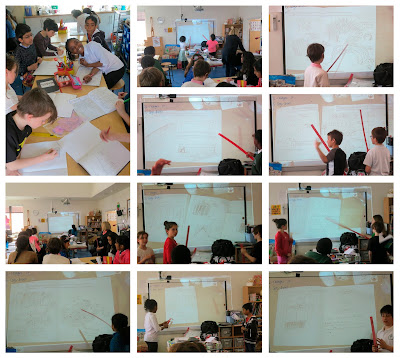Structures
Structures started our investigation. Experiments confirmed that triangles are the most stable shapes for use in a frame and panels offer structural properties in more shapes. Folded planes and interlocking sheets can create structures. They also looked at moving and transforming structures with Juno's Spinners, the Hobberman Sphere and the Jitter Bug.
3D Drawing
Tis next step in the sequence of work investigated ways in which ideas can be represented in three dimensions with axonometric paper, 3D pens and SketchUp.
Design
The Class was given the brief of designing a pavilion to engage with the environment and use energy in a productive way. A short introduction on pavilions with a few examples was given. With a relatively open set of parameters, the kids interpreted the brief with very unique and individual responses. Their engagement and focus in the exercise was such that there was no hesitation to standing up and presenting their ideas and the reasoning behind them.
Their designs
Their designs were represented with skills developed from the structural and 3D drawing workshops and also contained lots of personal content. As an exercise in imagining a space, the kids found it an opportunity to create something individual and meaningful to them. Here the workshops started to become an medium for personal expression.
Model Making
Using the drawn designs as a guide, materials were gathered which could be used to create their work in model form. This included straws, pipe cleaners, plastic and card sheets etc.
Models
Models were developed and refined over a couple of workshops.
Mid-size models
This, playing with cut and folded card.
This experimenting with newspaper made in to structural tubes to make framed structures.
Experimenting with interlocking sheets
Picking up on the ideas from previous years, estate agent boards were slotted to make a panel module which can be combined in to a number of different geometric shapes. At this scale, the boards made dens which the kids really enjoyed building and sharing with their friends.
Large scale pavilions
The goal of the workshops was to create some full size installations from the models created in the class room. The kids were keen to share ideas and combine their work to create different enclosures and spaces.
Here a series of vertical tubes swayed in the wind (the connection with energy). The bases were able to be repositioned creating different enclosures and sight lines through, making it adaptable and able to respond to different personal preferences.
Here two designs using folded structures were combined, which added to the spaces within the pavilion and made the structure more efficient. Energy was represented in the planes of the pavilion which could unfold or move to create different spacial arrangements.
This installation focused on personal energy and created a space to enjoy relaxation, experiencing the environment, passage of the clouds and the swaying of the installation in the wind.
The creativity of the kids seems boundless and it is encouraging that they saw the exercises as an opportunity to to invest so much personal content in to their work. Collectively the class collected a great body of work and we are looking forward to developing the programme with the school in the next academic year.












